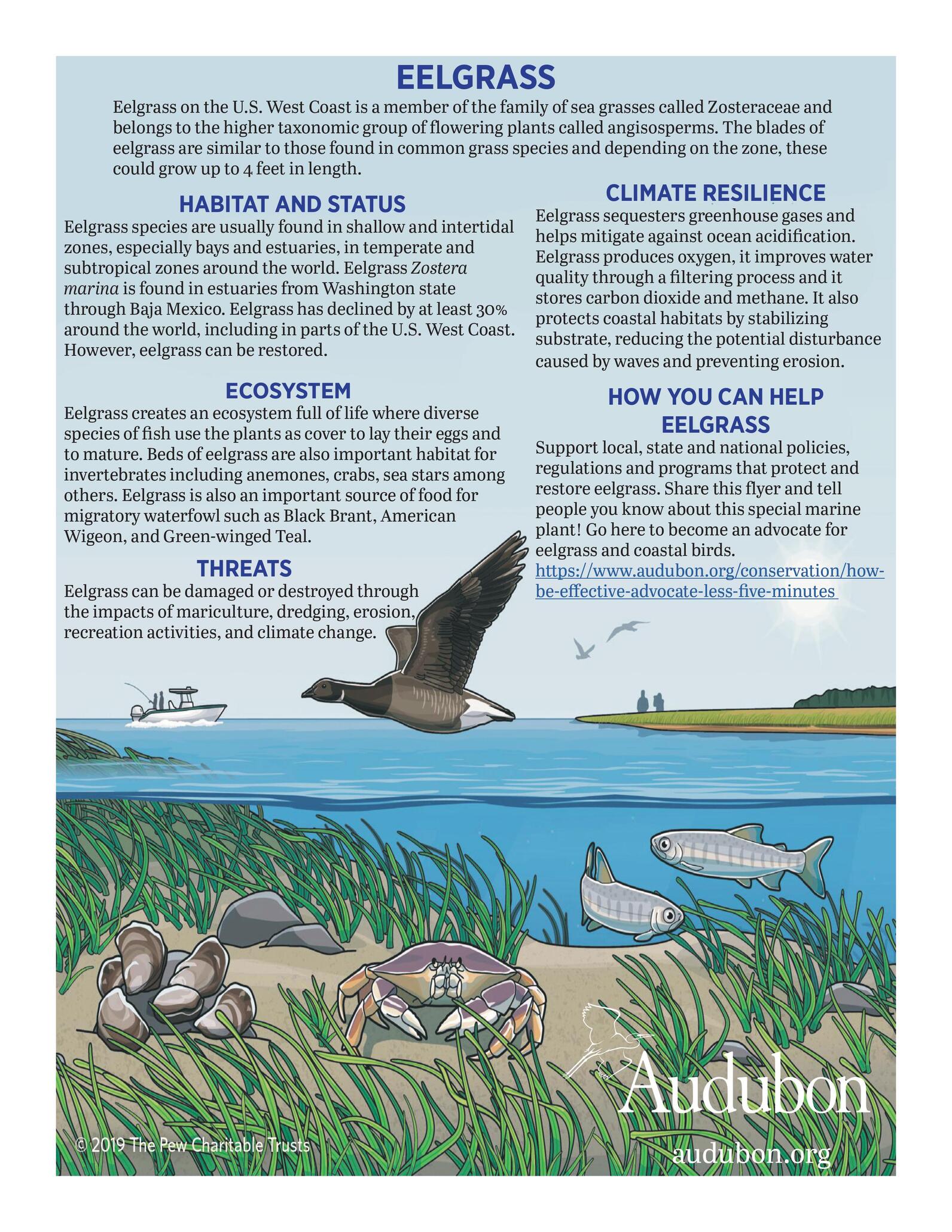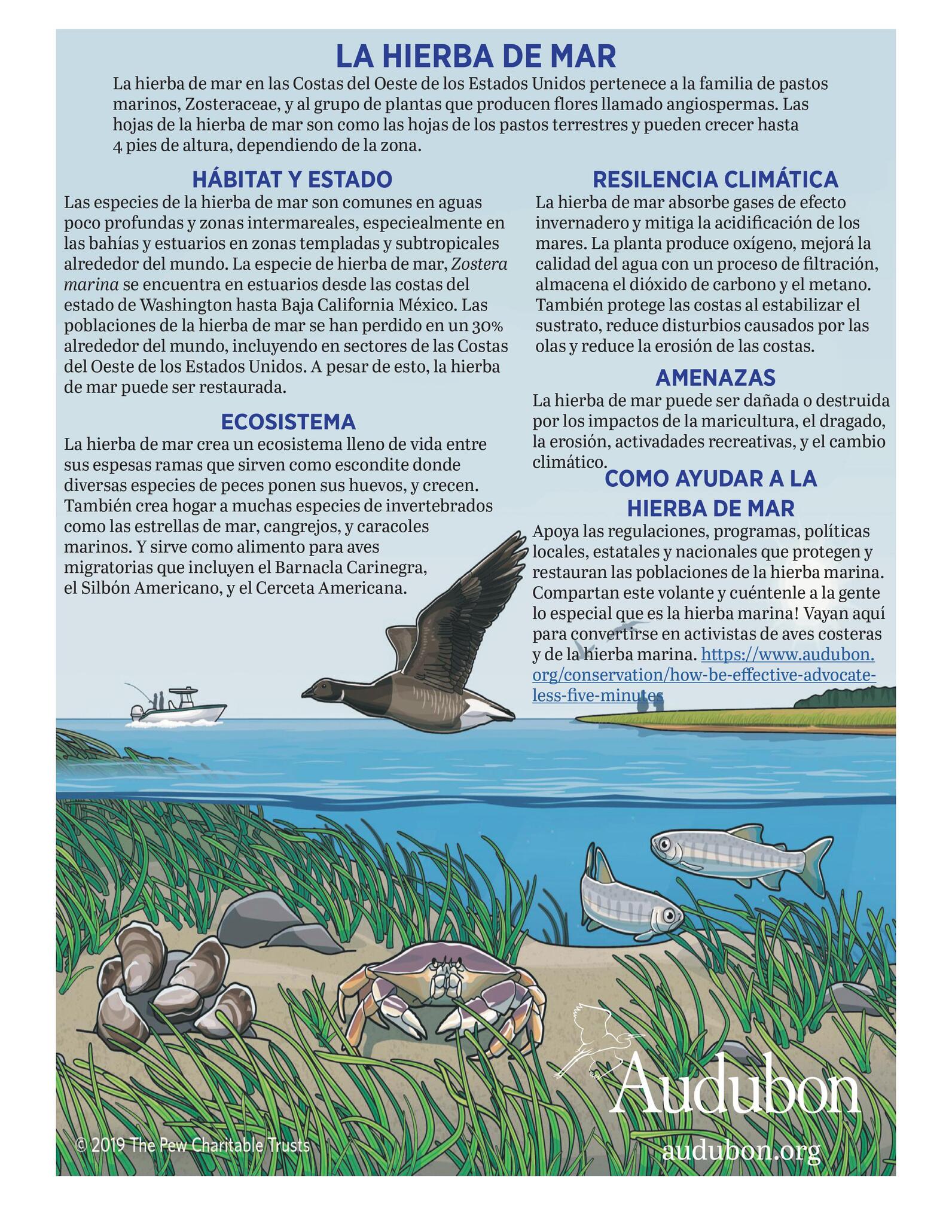All About Eelgrass
 |
 |
Eelgrass (Zostera marina)
Overview
Eelgrass, Zostera marina L., is the most widely occurring marine angiosperm in world, growing throughout the west and east coast of the United Sates, Canada and along the coast of Baja California. Eelgrass habitat acts as a protective nursery ground for finfish and shellfish, as an important food source for waterbirds, and as protection to coastal areas against shoreline erosion.
Eelgrass in Richardson Bay
Life history/ecology
Eelgrass is a true plant (not a seaweed) that grows submerged or partially floating in the marine environment. Eelgrass reproduces through rhizome growth and seed germination. Eelgrass grows on muddy and sandy bottoms in the shallow subtidal environment. Eelgrass beds grow rapidly in the spring and summer, then decay in the fall and winter. Dead eelgrass blades often wash up on the beach where their decay adds crucial nutrients to coastal environments.
Eelgrass functions and values
Role in the Marine Food Web
Eelgrass provides habitat and food for many marine species. Some waterfowl, such as Brandt and snails eat the leaves directly. Algae and invertebrate species use the eelgrass blades as substrate and some grow as epiphytes on the surface of the leaves. Eelgrass supports a large number of grazing crustaceans such as amphipods, crabs and shrimp. Bacteria, fungus and detritus (dead animal and plant matter) can also form a brown coating on dead leaves, which then provides food for small invertebrates.
Eelgrass Acts as a Nursery for Marine Animals
Herring are dependent on eelgrass for spawning. They lay eggs on eelgrass leaves and their young are protected within the eelgrass as they mature. During low tides, on tideflats, eelgrass beds hold moisture like a sponge, offering a safe, wet habitat for small creatures. With their extensive, intertwined root mats, eelgrass preserves the highly productive bacteria in the sediments which nourish many invertebrates by holding sediments in place and pumping oxygen below the muddy surface.
Some Threats to Eelgrass
Habitat alteration, recreational, industrial, commercial and residential development exert pressure on the shallow protected bays and estuaries required for eelgrass growth. Some of the major impacts include:
- Dredging can destroy eelgrass beds either directly or indirectly by reducing light penetration
- Upland erosion and construction activities can increase sedimentation which can smother eelgrass.
- Shoreline structures built over the water prevent eelgrass from getting enough light for growth.
- Excessive nutrients can accelerate algae growth on eelgrass blades, blocking out light.
Eelgrass in Richardson Bay
Richardson Bay is critically important to tens of thousands of diving ducks, grebes and other waterbirds who rely on the bay for roosting and feeding each winter. During the winter months Richardson Bay teems with Surf Scoters, Lesser and Greater Scaup, Western and Horned Grebes, Double-crested Cormorants and other birds. Richardson Bay is also well known for its annual winter herring runs that are an important local fishery and provide important food for wintering birds. There is concern that the long-term decline in bird numbers and herring in Richardson Bay and other parts of San Francisco Bay is linked to the decline in native eelgrass beds
Within San Francisco Estuary, Richardson Bay stands out as a particularly unique location for eelgrass restoration. It harbors the second largest extant eelgrass bed in the estuary, and plants with the most genetic diversity of six beds sampled. Further, a model of environmental conditions in the estuary has identified Richardson Bay as the area with the greatest area suitable for restoration (Merkel and Associates 2004). Hence, Richardson Bay is highly valued both for its existing eelgrass resources and its potential for restoration.
Eelgrass Restoration Techniques
Audubon California is working with partners from NOAA, San Francisco State University and Save The Bay to restore eelgrass habitat to Richardson Bay.
Restoration of eelgrass involves transplanting mature plants (shown bottom left) or seeds (shown bottom right) taken from healthy donor beds to a restoration site, once suitable environmental conditions have been established for eelgrass survival.
Transplanting adult plants involves planting the individual units by hand or by tying eelgrass to transplant frames called TERF’s (Transplanting Eelgrass Remotely with Frames, developed by Fred Short, University of New Hampshire) shown below.
How you can help, right now
Make a gift today
Help us engage future conservation leaders! When you sponsor a youth leader, you help the birds.
Become a part of our volunteer core!
Begin your volunteer journey today by finding the perfect fit for your talents.
Read our stories
Our bi-monthly e-newsletter is filled with incredible updates about our work.



